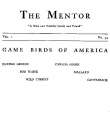You are here
قراءة كتاب The Mentor: Game Birds of America, Vol. 1, Num. 34, Serial No. 34
تنويه: تعرض هنا نبذة من اول ١٠ صفحات فقط من الكتاب الالكتروني، لقراءة الكتاب كاملا اضغط على الزر “اشتر الآن"

The Mentor: Game Birds of America, Vol. 1, Num. 34, Serial No. 34
most is how we can make this useful, companionable friend to man more plentiful. In the District of Columbia they have solved the problem by forbidding shooting for the last few years, and there in some places the chorus of Bob Whites sounds like that of the little frogs in springtime. A close season for five years on this bird would do more to stock the country than any other method now known; except, perhaps, in the northernmost part of its range, where it is sometimes almost exterminated by a severe winter. Eventually artificial propagation may solve our problem; for Bob White is a very prolific bird.
THE WILD TURKEY

Copyright, 1912, by Outdoor World and Recreation
THE WILD TURKEY
Often called the grandest bird of America.
The ruffed grouse may be the king of game birds in the field; but the wild turkey, the largest game bird that flies, is to my mind king of them all on the table. A young wild turkey, well roasted, is a dish for the gods. The domesticated turkey is not in the same class; nor is it a descendant of our wild turkey. It was bred from the Mexican turkey, a bird of another race, not so handsome as ours, and having a white rump. This turkey was domesticated by the Aztecs, and hundreds of thousands were bred by them in domestication long before America was discovered by Columbus. Europeans received the bird from the hands of the Indians. The white man never has succeeded in domesticating any American game bird sufficiently to bring it into general use. The task still lies before us. The American Ornithologists’ Union now recognizes but one species and five subspecies of the wild turkey, all of which are natives of this continent.

WILD TURKEY
This picture shows a female with its young. It is reproduced from one of the famous set of plates of “Birds of America,” made by J. J. Audubon.
The range of the species formerly extended over Mexico, most of the United States, and into southern Ontario. The early explorers found it roving in large flocks along the Atlantic seaboard, and at times migrating in great armies in search of food.

A WOODCOCK
We can form little idea today of the former almost incredible abundance of these noble birds. Our forefathers were accustomed to hunt them for the Thanksgiving dinner, and they rarely failed to secure a good supply. The bird is now extinct through the greater part of its former range. It was hunted, trapped, and shot at all seasons, and is likely to vanish from the earth unless it can be propagated under partial domestication and restored to its former habitat.
THE CANADA GOOSE
There is a quality in the cry of the wild geese returning northward in the spring that stirs the blood of all to whom the “Red Gods” call. That wild and solemn clamor ringing down the sky is as “the voice of one crying in the wilderness.” All eyes are turned to follow the baseless triangle drifting fast across the sky. What memories are awakened by that resounding call,—memories of open marsh or prairie, sounding shore and placid bay, lake or river, scenes of a wilderness of waters or of plains; for the wild goose is a bird of the waste places! Two hundred years ago it nested over the greater part of the continent; but civilization and market hunting have confined it now mainly to the vast morasses of the North, where it seeks some island in the marshy lands and there makes its


